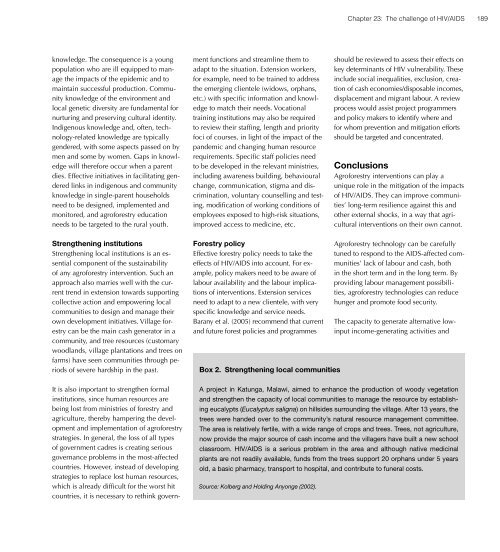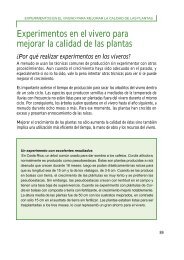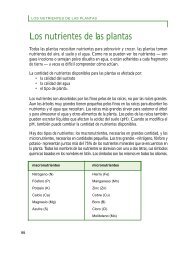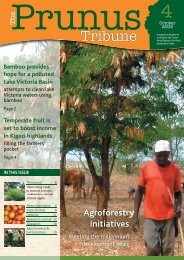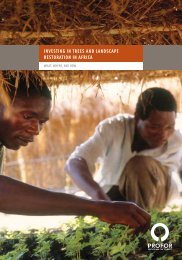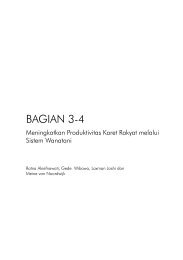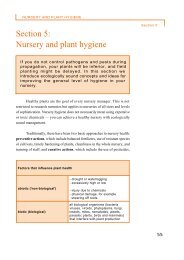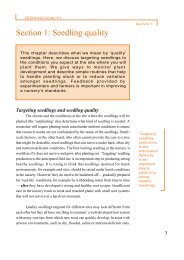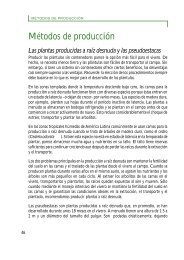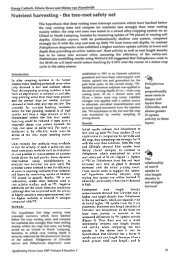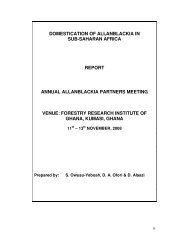Download as a PDF - World Agroforestry Centre
Download as a PDF - World Agroforestry Centre
Download as a PDF - World Agroforestry Centre
Create successful ePaper yourself
Turn your PDF publications into a flip-book with our unique Google optimized e-Paper software.
Chapter 23: The challenge of HIV/AIDS<br />
189<br />
knowledge. The consequence is a young<br />
population who are ill equipped to manage<br />
the impacts of the epidemic and to<br />
maintain successful production. Community<br />
knowledge of the environment and<br />
local genetic diversity are fundamental for<br />
nurturing and preserving cultural identity.<br />
Indigenous knowledge and, often, technology-related<br />
knowledge are typically<br />
gendered, with some <strong>as</strong>pects p<strong>as</strong>sed on by<br />
men and some by women. Gaps in knowledge<br />
will therefore occur when a parent<br />
dies. Effective initiatives in facilitating gendered<br />
links in indigenous and community<br />
knowledge in single-parent households<br />
need to be designed, implemented and<br />
monitored, and agroforestry education<br />
needs to be targeted to the rural youth.<br />
It is also important to strengthen formal<br />
institutions, since human resources are<br />
being lost from ministries of forestry and<br />
agriculture, thereby hampering the development<br />
and implementation of agroforestry<br />
strategies. In general, the loss of all types<br />
of government cadres is creating serious<br />
governance problems in the most-affected<br />
countries. However, instead of developing<br />
strategies to replace lost human resources,<br />
which is already difficult for the worst hit<br />
countries, it is necessary to rethink government<br />
functions and streamline them to<br />
adapt to the situation. Extension workers,<br />
for example, need to be trained to address<br />
the emerging clientele (widows, orphans,<br />
etc.) with specific information and knowledge<br />
to match their needs. Vocational<br />
training institutions may also be required<br />
to review their staffing, length and priority<br />
foci of courses, in light of the impact of the<br />
pandemic and changing human resource<br />
requirements. Specific staff policies need<br />
to be developed in the relevant ministries,<br />
including awareness building, behavioural<br />
change, communication, stigma and discrimination,<br />
voluntary counselling and testing,<br />
modification of working conditions of<br />
employees exposed to high-risk situations,<br />
improved access to medicine, etc.<br />
should be reviewed to <strong>as</strong>sess their effects on<br />
key determinants of HIV vulnerability. These<br />
include social inequalities, exclusion, creation<br />
of c<strong>as</strong>h economies/disposable incomes,<br />
displacement and migrant labour. A review<br />
process would <strong>as</strong>sist project programmers<br />
and policy makers to identify where and<br />
for whom prevention and mitigation efforts<br />
should be targeted and concentrated.<br />
Conclusions<br />
<strong>Agroforestry</strong> interventions can play a<br />
unique role in the mitigation of the impacts<br />
of HIV/AIDS. They can improve communities’<br />
long-term resilience against this and<br />
other external shocks, in a way that agricultural<br />
interventions on their own cannot.<br />
Strengthening institutions<br />
Strengthening local institutions is an essential<br />
component of the sustainability<br />
of any agroforestry intervention. Such an<br />
approach also marries well with the current<br />
trend in extension towards supporting<br />
collective action and empowering local<br />
communities to design and manage their<br />
own development initiatives. Village forestry<br />
can be the main c<strong>as</strong>h generator in a<br />
community, and tree resources (customary<br />
woodlands, village plantations and trees on<br />
farms) have seen communities through periods<br />
of severe hardship in the p<strong>as</strong>t.<br />
Forestry policy<br />
Effective forestry policy needs to take the<br />
effects of HIV/AIDS into account. For example,<br />
policy makers need to be aware of<br />
labour availability and the labour implications<br />
of interventions. Extension services<br />
need to adapt to a new clientele, with very<br />
specific knowledge and service needs.<br />
Barany et al. (2005) recommend that current<br />
and future forest policies and programmes<br />
Box 2. Strengthening local communities<br />
<strong>Agroforestry</strong> technology can be carefully<br />
tuned to respond to the AIDS-affected communities’<br />
lack of labour and c<strong>as</strong>h, both<br />
in the short term and in the long term. By<br />
providing labour management possibilities,<br />
agroforestry technologies can reduce<br />
hunger and promote food security.<br />
The capacity to generate alternative lowinput<br />
income-generating activities and<br />
A project in Katunga, Malawi, aimed to enhance the production of woody vegetation<br />
and strengthen the capacity of local communities to manage the resource by establishing<br />
eucalypts (Eucalyptus saligna) on hillsides surrounding the village. After 13 years, the<br />
trees were handed over to the community’s natural resource management committee.<br />
The area is relatively fertile, with a wide range of crops and trees. Trees, not agriculture,<br />
now provide the major source of c<strong>as</strong>h income and the villagers have built a new school<br />
cl<strong>as</strong>sroom. HIV/AIDS is a serious problem in the area and although native medicinal<br />
plants are not readily available, funds from the trees support 20 orphans under 5 years<br />
old, a b<strong>as</strong>ic pharmacy, transport to hospital, and contribute to funeral costs.<br />
Source: Kolberg and Holding Anyonge (2002).


